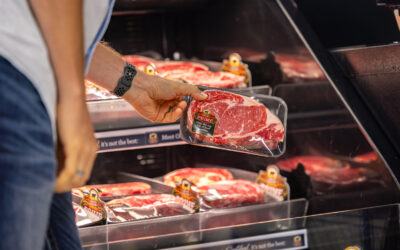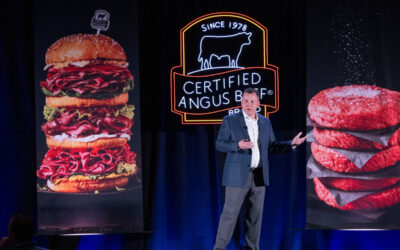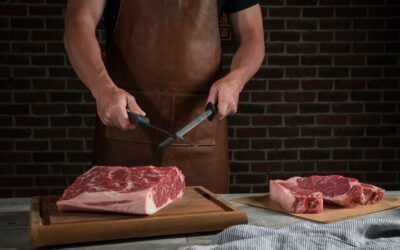
Beef market wants more Prime
by Steve Suther
When corn prices moved up a few years ago, many predicted cattle finishers would reduce days on feed and quality grades would suffer. Neither happened.
Instead, a paradigm shift swept through the U.S. feeding industry: those last days on feed are not so inefficient because cattle are growing carcass weight to sell on value-based grids. Supporting factors included the growing use of beta-agonists and the shrinking supply of feeder cattle that made replacements more costly.
That’s all part of the picture that shows a dramatic, 11.3-percentage-point gain in the share of Choice and Prime cattle in the five years that started in 2007, says Paul Dykstra, beef cattle specialist with the Certified Angus Beef ® brand who follows that data weekly in his “Rearview Mirror on Quality.”
“In the last two years the Choice and Prime share has settled into a steadier average above 65%,” he says. “But Prime and premium Choice brands have been garnering an increasing share of the declining supply.”
That had meant an even more dramatic decline in the share of the lower grade, Select beef, reflected in its recent run-up in price.
Rather than dig into those percentages, Dykstra charted reported loads of Prime and Select beef sold along with boxed beef prices for those grades (see Charts 1 and 2). Results illustrate the crossing lines of supply and demand that pushed Select higher, particularly in light of the demand from hamburger grinders.
“In contrast, the supply and market data for Prime beef shows higher prices paid in the face of more pounds of Prime beef sold,” Dykstra says.
Kansas State University economist Ted Schroeder attributes that disparity to the “niche” nature of the market.
“A small change in the relative supply of Prime would cause more of a price impact than a similar change in supply of Select,” he says. “That’s because Prime demand is more inelastic, and a small change in volume of Prime is potentially a sizeable percentage change.”
Jim Robb, Livestock Marketing Information Project director, attributes much of the initial grade improvement to the transition from human to camera grading. More recently he allows, “Some is genetics, but a lot of it is the removal of Zilmax from the system.”
Professional Cattle Consultants (PCC) president Shawn Walter disagrees on the impact of that beta-2 agonist. The market analyst based in Hydro, Okla., says most of the grade enhancement is linked to genetics.“
A lot of the uptrend in Prime grading came while we were feeding Zilmax to cattle that had already achieved their quality potential,” he says. “Then we removed it from the market and fed a little longer—not much—and we only overfed to the extent that it’s profitable. Grades are holding steady.”
Premium Choice is doing better. Some weeks this year saw a record 29% of Angus-influenced cattle qualify for CAB, double the ratio just a decade ago.


Premium Choice is doing better. Some weeks this year saw a record 29% of Angus-influenced cattle qualify for CAB, double the ratio just a decade ago.
Dykstra says market incentives play a key role. In 2013 the average Prime grid premium was $17/cwt. over Choice, on top of the $10 Choice-Select spread for most of the last two years. Thirty percent of the $450 million packers have paid in CAB grid premiums since its start in 1978 were in the past three years.
“Those are strong market signals,” he says, noting the Prime grid premium has averaged $20 over Choice for much of 2014. “It doesn’t look like those signals are easing up.”
Pratt (Kan.) Feeders manager Jerry Bohn credits a genetic focus on higher quality across all breeds.
“CAB has made inroads to the commercial cowherds, and competition has had an impact to where even the hybrid bulls aren’t just black but have higher marbling,” he says. “Drought liquidations culled the bottom end from a lot of Texas herds, too.”
Gage, Okla., feeder Dale Moore, Cattleman’s Choice Feedyard, credits drought.
“We don’t want a drought, but starting in south Texas and moving into Nebraska, it has made better cattlemen out of all of us,” he says. Culling started with obvious targets. “Then it came down to the wilder and less efficient. Finally it came to just keeping the best.”
Cattle feeders are more confident in the combination of better genetics and accurate carcass grading, Bohn adds. “We used to split a pen of cattle and find a 20-to 30-percentage-point swing in Choice grade from one plant to the next, but it’s a damn sight more consistent now.”
Meanwhile, the lower cost of gain and the removal of an aggressive beta agonist haven’t hurt. The shift to more and heavier cattle selling on value-based grids put the spotlight on premiums and cattle capable of earning them.
The Prime premium remains strong because that demand can’t be filled with the flip of a switch. Walter says cattle feeders recognize seasonal patterns in the Choice-Select spread and may incorporate that into planning. But they are not sure what to do about that constantly ringing Prime bell.
The industry reacts
“It’s not like they can just feed their cattle a couple weeks longer and make them grade Prime,” he says. Known genetic potential to gain and grade is a prerequisite for any plans to answer that call and collect the rewards.
Robb says cattle feeders have substantially changed management and marketing in the last five years as carcass weights increased through last fall, shifted gears and recovered since last fall.
“Having beta-agonists in the system moved the market to more grid and formula selling with less negotiation,” he says. “But holding onto the cattle longer this winter and spring paid off for feeders. Packers had to come chasing them and feeders reacted to that. It’s a complicated, biological system but lower cost of gains, adjusting implant programs and beta-agonists have all entered in.”
Walter says tight supplies mean volatile prices and greater risk will continue as well.
“People talk about commodity prices and ground beef, but quality is driving the market, and we might see quality premiums exaggerated this year,” he says. “If you maintain 4% Prime, that’s a smaller number of carcasses and demand is based on pounds.”
Break-even cattle feeding strategies are further complicated with $2,000 on the line for each animal and most of that paid for the calf.
Robb sees more of a lid on the price of beef and finished cattle than on the price of calves in the near term, with increasing “differentiation by ability to grade.”
“Buyers for the big feedyards were in Montana by January this year, buying unborn calves for fall delivery. Those are all calves with a known history for performance and grade,” Robb says.
You may also like
CAB Sets Sales Records, Sees Historically High Brand Acceptance Rates
In an otherwise tough time in the beef business, sales and supply records have been a bright spot. The positive numbers mean that quality beef production has not let up, and beef demand is holding. Consumers have proven the value proposition: the good stuff is worth a little more money, for a better eating experience.
Making Sense of Supply, Pricing and Navigating the Market
Amid anticipated shifts in cattle supply and evolving market dynamics, CAB remains well-positioned to navigate the beef sales road ahead. Clint Walenciak addressed how producer profitability, strategic specification adjustments, and resilient demand will help stabilize the brand’s beef supply chain through herd size and pricing shifts in 2025 and beyond.
Thriving with Shrinking Supply
Even as the nation’s cow herd contracts, “more pounds” and “higher quality” have been common themes. Specific to commercial cattlemen: It still pays to focus on carcass merit, in addition to other economically relevant traits.



